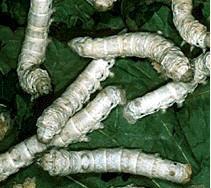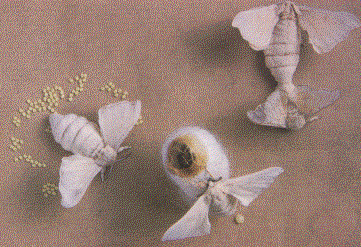

Becoming
a Moth
While inside the cocoon, the silkworm sheds its skin and becomes a pupa as shown below. Inside the brown pupa shell, it slowly changes into a moth. This process takes three weeks.

The moths usually emerge at dawn. The adult moth has a special spit which is used to dissolve the silk so it can push its way out of the cocoon. Silkworm farmers kill the moths before they emerge and make holes in the silk thread. When they emerge, the wings are crumpled, but they get pumped full of fluid and harden it about an hour.
Moths cannot fly, and neither eat nor drink. They mate, lay eggs, and then die within five days. After the moths emerge from the cocoon, they look for an opposite-sex moth to mate with. Females are significantly larger than males. Females periodically extrude a scent gland through the hole in their abdomen. Males have a flap of skin at the end of their abdomen and flutter their wings a lot. Each moth will "urinate" a reddish-brown fluid shortly after emerging from the cocoon. It dries to look like blood. Explain to the kids that this is the moth's "pee" that it saved up since it couldn't "go" while it was in the cocoon.

The moths stay mated for about a day. In the picture, notice how much larger the female is. After separation, the female lays eggs and the male looks for another female. Sometimes another male grabs the female before she can lay eggs. Each female will lay between 200 - 500 golden yellow eggs! Put paper on the bottom of the container and remove empty cocoons as the moths emerge. The moths will lay eggs on the paper. When the moths are dead, you might want to save them to make display cases.
It is interesting to note that 40,000 silkworm eggs (once ounce or 28 grams) will hatch into worms which will eat 6,500 kilograms (3,500 pounds) of mulberry leaves, and will spin cocoons which will produce 8 kilograms (18 pounds) of silk thread. It takes 1700 to 2000 cocoons to make one silk dress!
To continue to the next stage of development, click on Eggs again!